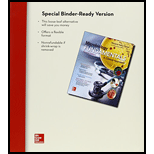
a.
To determine:
The direction of replication of the new strand and also explain leading and lagging strands.
Concept introduction:
a.
Explanation of Solution
Pictorial representation: DNA replication is represented as below:
Fig. 1: DNA replication.
Replication process begins with unwinding of double DNA strand with the help of DNA helicase enzyme. This results in the formation of replication fork. Each separated DNA strands act as template to synthesize two new strands.
Replication of given segment of DNA:
The two parental strands are anti parallel to each other thus newly synthesized daughter strands are also anti parallel. DNA strand is always formed in
The new nucleotides formed, pairs with their complementary bases with old parental strands. One strand is called leading strand (
DNA replication takes place by two ways: DNA strand from
b.
To explain:
Semiconservative replication and whether new strands are identical to the original segment of DNA.
Concept introduction:
In DNA replication, a double stranded DNA molecule is produced with two complementary strands of nucleotides. Parental strand (old) unwinds and separates at several points by breaking the hydrogen bond forming the replication fork. Once the strands get separated, each parental strand provides a template that contains nucleotides and complementary
b.
Explanation of Solution
DNA replication is considered as semi conservative because the newly synthesized DNA molecules have one strand of parental DNA that act as template for the formation of new daughter DNA strands. Thus, each DNA molecule has one old and one new strand.
Both DNA molecule formed contain one old parental strand and one newly synthesized daughter strand. Thus, only one strand of daughter strand is identical to parental old strands.
DNA replication is semi conservative as newly synthesized DNA strands conserve one old parental strand along with the new daughter strand.
Want to see more full solutions like this?
Chapter 8 Solutions
Loose Leaf For Microbiology Fundamentals: A Clinical Approach
 Human Anatomy & Physiology (11th Edition)BiologyISBN:9780134580999Author:Elaine N. Marieb, Katja N. HoehnPublisher:PEARSON
Human Anatomy & Physiology (11th Edition)BiologyISBN:9780134580999Author:Elaine N. Marieb, Katja N. HoehnPublisher:PEARSON Biology 2eBiologyISBN:9781947172517Author:Matthew Douglas, Jung Choi, Mary Ann ClarkPublisher:OpenStax
Biology 2eBiologyISBN:9781947172517Author:Matthew Douglas, Jung Choi, Mary Ann ClarkPublisher:OpenStax Anatomy & PhysiologyBiologyISBN:9781259398629Author:McKinley, Michael P., O'loughlin, Valerie Dean, Bidle, Theresa StouterPublisher:Mcgraw Hill Education,
Anatomy & PhysiologyBiologyISBN:9781259398629Author:McKinley, Michael P., O'loughlin, Valerie Dean, Bidle, Theresa StouterPublisher:Mcgraw Hill Education, Molecular Biology of the Cell (Sixth Edition)BiologyISBN:9780815344322Author:Bruce Alberts, Alexander D. Johnson, Julian Lewis, David Morgan, Martin Raff, Keith Roberts, Peter WalterPublisher:W. W. Norton & Company
Molecular Biology of the Cell (Sixth Edition)BiologyISBN:9780815344322Author:Bruce Alberts, Alexander D. Johnson, Julian Lewis, David Morgan, Martin Raff, Keith Roberts, Peter WalterPublisher:W. W. Norton & Company Laboratory Manual For Human Anatomy & PhysiologyBiologyISBN:9781260159363Author:Martin, Terry R., Prentice-craver, CynthiaPublisher:McGraw-Hill Publishing Co.
Laboratory Manual For Human Anatomy & PhysiologyBiologyISBN:9781260159363Author:Martin, Terry R., Prentice-craver, CynthiaPublisher:McGraw-Hill Publishing Co. Inquiry Into Life (16th Edition)BiologyISBN:9781260231700Author:Sylvia S. Mader, Michael WindelspechtPublisher:McGraw Hill Education
Inquiry Into Life (16th Edition)BiologyISBN:9781260231700Author:Sylvia S. Mader, Michael WindelspechtPublisher:McGraw Hill Education





